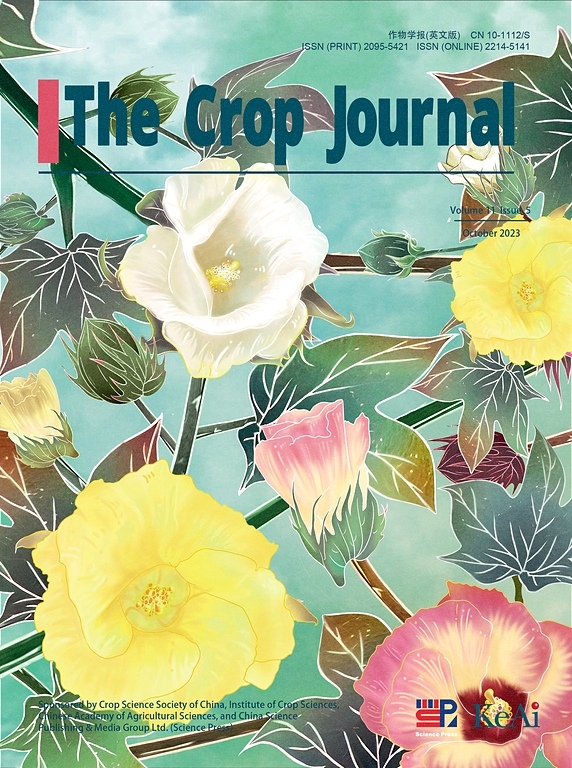氮对小麦小花原基发育的动态调控
IF 5.6
1区 农林科学
Q1 AGRONOMY
引用次数: 0
摘要
氮肥对穗和小花的发育至关重要,影响每穗可育小花数。然而,氮肥对小花发育过程的生理调控在很大程度上是未知的。在0 (N0)、120 (N1)和240 (N2) kg ha - 1 3个施氮水平下,对小花原基数量、形态、干物质和氮有效性进行了高时间分辨率的研究。有趣的是,开花期的可育小花是由抽穗期具有减数分裂能力的小花原基决定的,减数分裂能力是预测小花原基成为可育小花还是败育小花的一个阈值。由于中心小穗第4小花原基的发育速度加快,获得减数分裂能力,NFFs随施氮量的增加而逐渐增加,但在N2处理下增加幅度减小。穗氮浓度在各处理间无显著差异,而叶片氮浓度在N1和N2处理间均有提高。相应的,N1和N2处理的叶片和穗干物质积累量和氮含量均比N0处理增加。显然,最佳施氮量增加了叶片氮素有效性和同化物向穗部的转运,使更多的小花原基获得减数分裂能力并成为可育小花,最终提高了NFFs。N1与N2处理的叶片氮含量无显著差异,而N2处理的0 ~ 60 cm土层土壤氮含量高于N1处理,说明仍有部分氮肥未被利用。因此,提高叶片进一步利用氮肥的能力对于提高NFFs至关重要。本文章由计算机程序翻译,如有差异,请以英文原文为准。
A dynamic regulation of nitrogen on floret primordia development in wheat
Nitrogen (N) fertilization is critical for spike and floret development, which affects the number of fertile florets per spike (NFFs). However, the physiological regulation of the floret development process by N fertilization is largely unknown. A high temporal-resolution investigation of floret primordia number and morphology, dry matter, and N availability was conducted under three N fertilization levels: 0 (N0), 120 (N1) and 240 (N2) kg ha−1. Interestingly, fertile florets at anthesis stage were determined by those floret primordia with meiotic ability at booting stage: meiotic ability was a threshold that predicted whether a floret primordium became fertile or abortive florets. Because the developmental rate of the 4th floret primordium in the central spikelet was accelerated and then they acquired meiotic ability, the NFFs increased gradually as N application increased, but the increase range decreased under N2. There were no differences in spike N concentration among treatments, but leaf N concentration was increased in the N1 and N2 treatments. Correspondingly, dry matter accumulation and N content of the leaf and spike in the N1 and N2 treatments was increased as compared to N0. Clearly, optimal N fertilization increased leaf N availability and transport of assimilates to spikes, and allowed more floret primordia to acquire meiotic ability and become fertile florets, finally increasing NFFs. There was no difference in leaf N concentration between N1 and N2 treatment, whereas soil N concentration at 0-60 cm soil layers was higher in N2 than in N1 treatment, implying that there was still some N fertilization that remained unused. Therefore, improving the leaf’s ability to further use N fertilizer is vital for greater NFFs.
求助全文
通过发布文献求助,成功后即可免费获取论文全文。
去求助
来源期刊

Crop Journal
Agricultural and Biological Sciences-Agronomy and Crop Science
CiteScore
9.90
自引率
3.00%
发文量
638
审稿时长
41 days
期刊介绍:
The major aims of The Crop Journal are to report recent progresses in crop sciences including crop genetics, breeding, agronomy, crop physiology, germplasm resources, grain chemistry, grain storage and processing, crop management practices, crop biotechnology, and biomathematics.
The regular columns of the journal are Original Research Articles, Reviews, and Research Notes. The strict peer-review procedure will guarantee the academic level and raise the reputation of the journal. The readership of the journal is for crop science researchers, students of agricultural colleges and universities, and persons with similar academic levels.
 求助内容:
求助内容: 应助结果提醒方式:
应助结果提醒方式:


